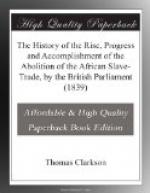But the increase of the Negroes, where their treatment was better than ordinary, was confirmed in the evidence by instances in various parts of the world. From one end of the continent of America to the other, their increase had been undeniably established; and this to a prodigious extent, though they had to contend with the severe cold of the winter, and in some parts with noxious exhalations in the summer. This was the case, also, in the settlement of Bencoolen in the East Indies. It appeared from the evidence of Mr. Botham, that a number of Negroes, who had been imported there in the same disproportion of the sexes as in West Indian cargoes, and who lived under the same disadvantages, as in the islands, of promiscuous intercourse and general prostitution, began, after they had been settled a short time, annually to increase.
But to return to the West Indies.—A slave-ship had been, many years ago, wrecked near St. Vincent’s. The slaves on board, who escaped to the island, were without necessaries; and, besides, were obliged to maintain a war with the native Caribbs: yet they soon multiplied to an astonishing number; and, according to Mr. Ottley, they were now on the increase. From Sir John Dalrymple’s evidence it appeared that the domestic slaves in Jamaica, who were less worked than those in the field, increased; and from Mr. Long, that the free Blacks and Mulattoes there increased also.
But there was an instance which militated against these facts (and the only one in the evidence), which he would now examine. Sir Archibald Campbell had heard that the Maroons in Jamaica, in the year 1739, amounted to three thousand men fit to carry arms. This supposed their whole number to have been about twelve thousand; but in the year 1782, after a real muster by himself, he found, to his great astonishment, that the fighting men did not then amount to three hundred. Now the fact was, that Sir Archibald Campbell’s first position was founded upon rumour only, and was not true; for, according to Mr. Long, the Maroons were actually numbered in 1749, when they amounted to about six hundred and sixty in all, having only a hundred and fifty men fit to carry arms. Hence, if when mustered by Sir Archibald Campbell he found three hundred fighting men, they must from 1749 to 1782 have actually doubled their population.




